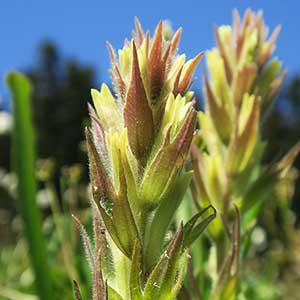Castilleja chambersii
Castilleja cryptantha
Chambers' Indian paintbrush, Chambers' paintbrush
Mt. Rainier or obscure paintbrush, obscure Indian paintbrush, obscure paintbrush
solitary or few to several, ascending, sometimes short-decumbent and rooting, branched from near base, sometimes distally, glabrous or glabrate with hairs very sparse, ± appressed, very short, soft, eglandular.
few to several, erect or ascending, unbranched, hairs spreading, long, soft, eglandular, mixed with short stipitate-glandular ones.
green, often brown- or purple-tinged, oblong to lanceolate to narrowly ovate or ovate, (1–)2–5.8 cm, not fleshy, margins plane, ± involute, deeply 3–7(–11)-lobed, sometimes with secondary lobes, apex narrowly acute;
lobes erect to ascending, lanceolate to linear-lanceolate to oblanceolate, apex acute.
green, often with brown or purple veins, narrowly to broadly lanceolate, 1.5–4 cm, not fleshy, margins plane, ± involute, 0–3-lobed, apex acute to acuminate;
lobes spreading-ascending, narrowly lanceolate, apex acute to ± obtuse.
3–15 × 2–4.5 cm;
bracts proximally greenish, distally bright red, scarlet, or pale reddish orange, rarely orange-yellow, often fading to pale yellowish orange with age, obovate to orbicular, fan-shaped, (3–)5–9(–13)-lobed, sometimes with secondary lobes;
lobes erect or ascending, lanceolate to triangular, short and medium length, usually arising at or above mid length, rarely below, apex acute.
(2.5–)3–6 × 1–2 cm; green to dull brown or dull reddish purple throughout, or proximally green to dull brown or dull reddish purple, distally yellow on apices, broadly lanceolate to ovate, (0–)3-lobed;
lobes ascending, narrowly lanceolate, long or short, arising near mid length, apex acute or acuminate.
straight, 30–45 mm;
tube 14–19 mm;
beak long-exserted, adaxially green or yellow-green to brownish, 18–24 mm;
abaxial lip deep green, reduced, 1–3 mm, 10% as long as beak;
teeth incurved, greenish to dull purplish, 0.5–1.5 mm.
straight, 14–16 mm;
tube 11–14 mm;
whole corolla included within calyx;
beak adaxially pale yellow, 1–2 mm;
abaxial lip deep green, slightly inflated, 4–5 mm, 67% as long as beak;
teeth ascending, pale, 1.5–2 mm.
proximally green, sometimes purple to brown, distally colored as bracts, 20–30 mm;
abaxial and adaxial clefts 7–14 mm, ca. 33% of calyx length, deeper than laterals, lateral 2–4 mm, 10–15% of calyx length;
lobes triangular, barely longer than wide, apex acute or acuminate to obtuse.
proximally green or pale with green veins, lobes yellow, sometimes becoming deep red with age, 12–15 mm;
abaxial and adaxial clefts 3–7 mm, 25–50% of calyx length, deeper than laterals, lateral 1–3(–4) mm, 8–20% of calyx length;
lobes triangular, adaxial segments longer than abaxials, apex acute or obtuse.
= 24.
= 24.
Castilleja chambersii
Castilleja cryptantha
Castilleja chambersii is limited to the summits of three volcanic peaks in the northern Coast Range of Clatsop County, Oregon, and at one similar area in nearby Pacific County, Washington. It is similar to C. rupicola, and the two likely share a common ancestor. Disturbance and erosion from logging and road construction represent significant threats to C. chambersii. Populations of C. chambersii often grow near and even alongside C. hispida, but hybrids are rare.
(Discussion copyrighted by Flora of North America; reprinted with permission.)
Castilleja cryptantha is endemic to the vicinity of Mt. Rainier in the Cascade Range, with most populations found within Mt. Rainier National Park. Unlike most species of Castilleja, it is apparently self-pollinating (W. J. Duffield 1972); the small flowers are entirely enclosed within the yellowish calyces, which tend to grow deep reddish as they age. The purplish brown bracts are also unusual in the genus.
(Discussion copyrighted by Flora of North America; reprinted with permission.)



